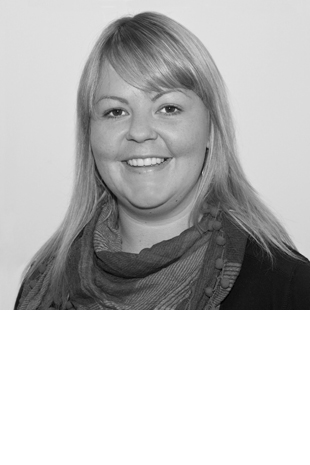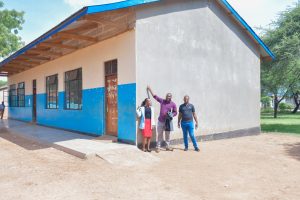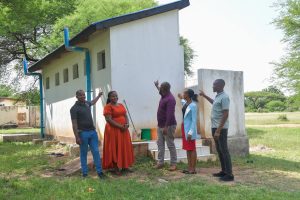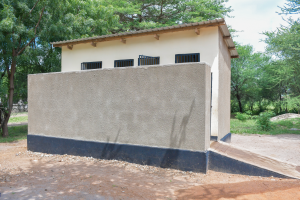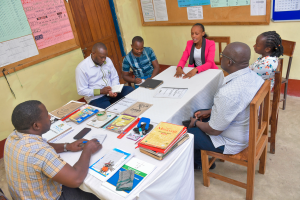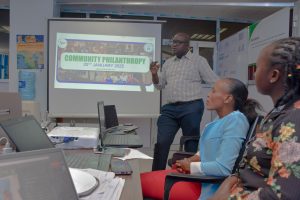The tale of two schools, Shinyanga, Tanzania
06 Feb 2025
This blog originally appeared on the Nguzo Africa website.
In the wake of US foreign aid freeze, the role of community philanthropy is on the spot. How can we use philanthropy to accelerate community-led development, create flourishing people, build community power and assets?
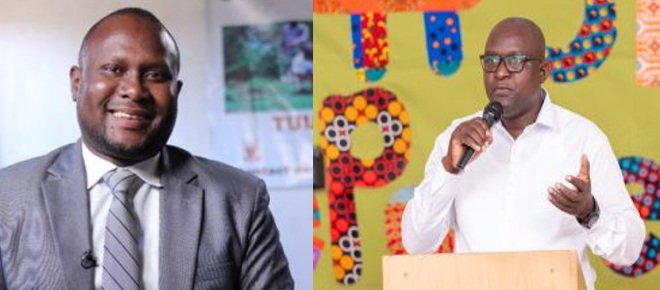
(L – R): Elizaphan Ogechi, Nguzo Africa & Jonathan Kifunda, Thubutu Africa Initiatives
On a sunny afternoon, on 23 January 2025, we took a field trip to experience how community philanthropy (hizani, harambee, ubuntu) transforms development in Africa. Thubutu Africa Initiatives, the host of a learning exchange with Nguzo Africa from Kenya, took us to two public primary schools whose leaders had graduated from community philanthropy trainings, mentorship and coaching.
The leaders of both two schools were trained by the same facilitators, coached, and offered mentorships to implement community philanthropy and local fundraising actions in their respective schools. Both were filled with dreams of raising enough resources to construct modern toilets for girls to reduce congestion in the limited facilities, improve hygiene, and have a conducive school learning environment.
But when we visited, three years since they took this task on, teams from both schools were excited about their progress in community philanthropy. They were both happy that their actions were bringing some positive change in their respective schools.
But there was one difference…
One of these schools had used community philanthropy to construct a modern six-room toilet facility, two modern classrooms, and renovated floors of two classes, and there was high optimism for the implementation of school projects using the same approach. This school is now the best-performing public primary school in the Shinyanga region. The other school is still struggling, and their leaders were on the verge of giving up. Resources raised had constructed a stalled modern toilet. There was a lack of synergy among the community, parents and school management. Because of this disconnect, the government constructed a new separate three-room modern toilet, near the stalled one. Overall, in this school, the school learning environment was poor, a low environment for learners and their school academic performances are wanting.
What made the difference?
In our evening and morning reflections, we wondered what might have made this huge difference, as the two schools are in the same neighbourhood and their leaders were trained using the same content.
We noted that the difference lies in leadership, connections to what one knows, and how one makes use of that knowledge for a great impact in the community. In the successful school, we saw enthusiasm, passion and the dedication of the school management and other stakeholders. They executed their actions with a confident winning mentality. There was coordination, transparency and no duplication of actions. This also trickled-down to learners who took co-ownership of the fundraising initiative because they knew the value of good hygiene and were able to persuade their parents and the entire community to contribute. The local fundraising process was driven by the changed mind-set of the entire community – learners, parents, leaders, teachers and government. They all decided to do good.
Second, to succeed in local fundraising, you need to establish an action-oriented committee made of people who have past records of development. People who are able to lend out their contributions, both in-kind and monetary. In the successful school, the majority of the resources raised were in-kind. Parents gave sand, bricks, labour and meals, and local business-people gave cement. The government officials gave architectural designs and paid trained local artisans to finalize the construction of the facility.
Third, there was also a high level of trust and transparency. The successful school opened a project school account where all contributions were banked. All expenditures were recorded and reported back to committee members and parents.
Fourth, everyone who participated in this successful fundraising campaign was recognized with certificates, and their names were announced during parents’ meetings. Their names were written on school noticeboards and in facilities that were be constructed. This created guilty consciousnesses among those who failed to to contribute. Luckily, they committed to participate in the next fundraiser.
Fifth, there was consistency in follow-up. The plans were set, and each of the members was given roles and actions to fulfill. A database of alumni, prominent community members, leaders, government officials, and business leaders were used to make these follow-ups, and communicate back to them on the progress.
“Parents and the entire community have embraced community philanthropy as a way of improving school infrastructure and performance. It is not easy to reach to achieve this. You must have the right committee, plan, give roles, map out potential community donors and make follow-ups. Above all to be very passionate, transparent and trusted in all the actions. This has allowed our team to easily interact with parents, leaders and government to achieve the common goal of improving school performance,” said Stella Lukas Halimoja, Head of School, Lubaga Primary School.
Japhet Tibesigwa Jasson, Head of School, Mapinduzo B Primary School affirms that through community philanthropy, the school community – including learners, teachers, parents and local leaders – are so energized to undertake school projects for improved school performance.
“Through these interactions, we are now used to receiving visitors who want to learn from our success. This has made our learners maintain high levels of hygiene and keep our environment clean. We were the number two best performing public primary school in Shinyanga region,” said Japhet Tibesigwa.
Japhet adds that when a community is well-guided, people get involved and they take charge of their own development. This approach builds friends and makes it easy to do big things in resource constrained settings. He is motivated by the spirit of giving among teachers, parents and community members towards a common goal. He added that girls who were skipping school during their periods are now happy using the constructed facilities. He said community philanthropy should be replicated and supported, because it strengthens people, skills and directs resources for impact.
Results
The results of these approaches have made it easy for committed schools to undertake development that is community-driven. Development that builds on community power and assets for flourishing people. This approach has created a ripple effect for doing good in the community. In the school that succeeded, we were informed that a local businessman donated the printer to facilitate school learning activities.
Community philanthropy is not a silver bullet that can succeed everywhere. There are some areas where it fails to work completely. It takes a natural mix of various factors for it to succeed and achieve intended results. Trust, willingness to do good and having strong leadership in the community are critical ingredients for success.
Setting the pace for “development with dignity”
Despite its challenges, community philanthropy is setting the pace for development with dignity. These cases showcase how development can be done with dignity and respect for people, their cultures and assets. Now, albeit slowly, we see this as a viable approach to stymie failed foreign aid development models.
Community philanthropy offers people in resource-constrained settings an avenue to define their destiny, develop their self-determination frameworks, define, solve and own their viable paths to prosperity.
The role played by the Kenya Community Development Foundation, I&M Foundation, GFCF, Root Change, Mott Foundation, Bridgespan, among other partners in promoting community-driven development, community philanthropy and building the financial resilience of people and community organizations should be amplified and replicated.
Special thanks to
- Stella Lucas Halimoja, Head of School, Lubaga Primary School
- Japhet Tibesigwa Jasson, Head of School, Mapinduzi B Primary School
- Teams from Thubutu Africa Initiatives and Nguzo Africa
- Participating learners, teachers, parents and government teams
- Gilitu Makula, Director, Gilitu Enterprises Ltd.
- Local business leaders, community leaders and government officials
By: Elizaphan Ogechi, Executive Director of Nguzo Africa and Jonathan Kifunda, Executive Director of Thubutu Africa Initiatives

